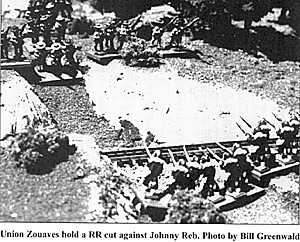 The value of wargame campaigns has often been expressed. The difficult
aspect of campaigning remains, not to generate enthusiasm, but rather to
maintain the interest and enjoyment, during and after the campaign.
The value of wargame campaigns has often been expressed. The difficult
aspect of campaigning remains, not to generate enthusiasm, but rather to
maintain the interest and enjoyment, during and after the campaign.
Union Zouaves hold a RR cut against Johnny Reb. Photo by Bill Greenwald
When campaigning upon maps, compared to a set series of battles, there often occur many minor contacts. Often there are multiple engagements or very small unit contacts which drag out the campaign and add little to the material results.
One may then resolve a contact into either a skirmish or a battle. A skirmish is where one or the other desires to use the skirmish results in a pure cavalry encounter, pure cavalry battles only occur if both sides agree, or if the total figures are below the number needed to have a battle. This number is, of course, set sufficiently high to avoid too many battles.
Various methods can be employed to resolve a skirmish. There can be a simple odds chart (see table below) which resolves the outcome and casualties based upon the comparative size of the forces. This method has the advantage of ease in operation, and quick results.
One may wish to employ a more complicated affair which requires a multitude of inputs (troop strength, troop type, terrain, supply, etc.) but which also may give a more varied output (loss of morale, various retreat distances, dispersion, etc.).
If the contact is not a skirmish, it is a battle, which must be decided on the tabletop. This should be set up in the traditional manner. The tabletop battle is fought until the number of turns per map move is reached, with regard to the tabletop size and other specific tactical rules being used. All units except those in battle are then moved in the usual manner on the campaign map. It sometimes allows the entrance of reinforcements into the battle.
Using this approach, only the major engagements will be taken to the tabletop. There may be skirmishes or raids of great importance that both parties may wish to play out. These smaller actions are naturally up to the consideration of the participants.
A problem does arise after the battle: pursuit. The continued flow of the campaign and the effect of a pursuit may be achieved by fighting the pursuit on the tabletop too, as an extension of the normal battle. In this case, one cannot just announce his withdrawal, but must physically get his army off the table. There must be a point (army 'CE" breakpoint: CE = Combat Effectiveness) at which an army normally begins withdrawal. A withdrawal "in order" might have the stipulation that 2/3rds of the remaining force (after the breakpoint is reached) must be retreated off the table in perhaps three turns - to allow for the needed rearguard. If this is not achieved, those not withdrawn, or possible a portion thereof, may be considered captured by the inevitable pursuit.
A CE rout could require that all units immediately turn and by normal movement proceed to the baseline, while the victor continues the action until all routed units leave the table. After the pursuit, and returning to the map, the defeated army is moved back an appropriate distance and the victor gains possession of the battlefield. A drawn game, either by mutual consent or by the CE outcome, would result in the separation of the armies to just outside contact distance.
These ideas you can surely be expanded upon and introduced into campaigns to produce smooth results while maintaining interest and avoiding unnecessary difficulties.
| DIE ROLL | ODDS | |||
|---|---|---|---|---|
| 1-1 | 1.5-1 | 2-1 | 3-1 | |
| 1 | 10%-R | 10%-R | 15%-R | 20%-R |
| 5%-H | 5%-H | 5%-H | 5%-H | |
| 2 | 5%-R | 10%-R | 10%-R | 15%-R |
| 5%-H | 5%-H | 5%-H | 5%-H | |
| 3 | 5%-H | 5%-R | 10%-R | 15%-R |
| 5%-H | 5%-H | 5%-H | 5%-H | |
| 4 | 5%-H | 5%-H | 10%-H | 15%-H |
| 5%-R | 5%-H | 5%-H | 5%-H | |
| 5 | 5%-H | 10%-H | 10%-H | 10%-H |
| 5%-R | 5%-H | 5%-H | 5%-H | |
| 6 | 5%-H | 5%-H | 10%-H | 10%-H |
4-1 or greater: lesser side automatically retires with 15% casualties, greater side automatically holds with no casualties
10%-H: Lesser Side
5%-H: Greater Side
Hold (H) or Retire(R), X% = Casualties to the side
To determine odds, compare the greater side (total of figures plus artillery poundage) to the lesser side (also figures plus poundage). Then roll one die. The die roll and odds are cross referenced to produce the result. The upper line of the results table shows the casualties (% of the total force used) to the LESSER force, the lower line the casualties to the GREATER force. After the casualties is a letter code indicating whether that side holds its position (H), or retreats one move to the rear (R).
Back to Table of Contents -- Courier #77
To Courier List of Issues
To MagWeb Master Magazine List
© Copyright 1999 by The Courier Publishing Company.
This article appears in MagWeb (Magazine Web) on the Internet World Wide Web.
Other military history articles and gaming articles are available at http://www.magweb.com